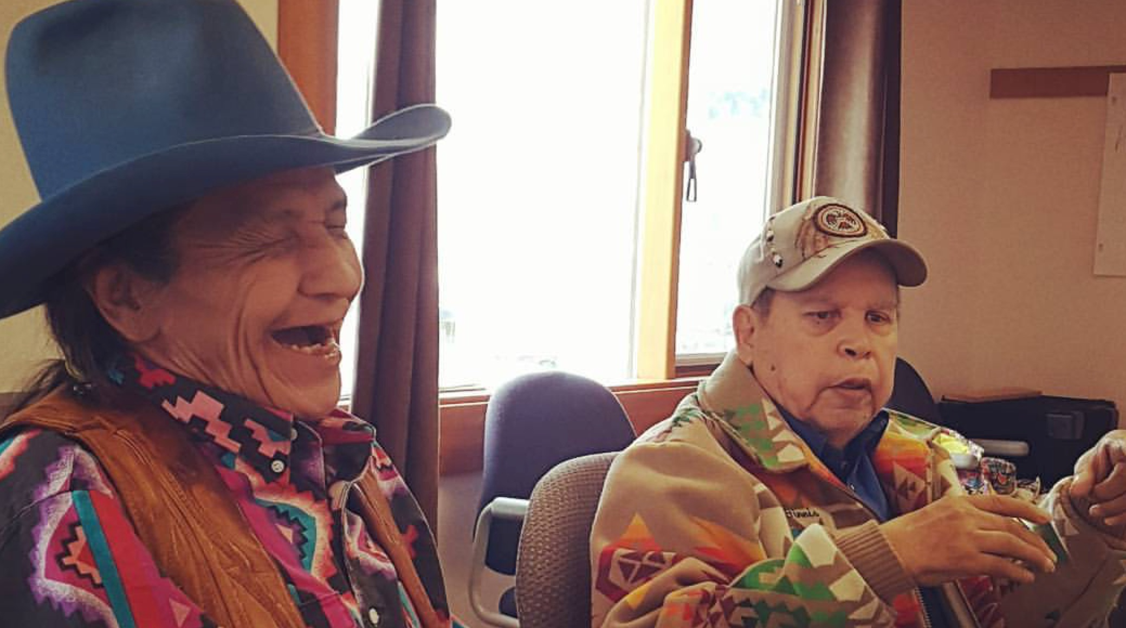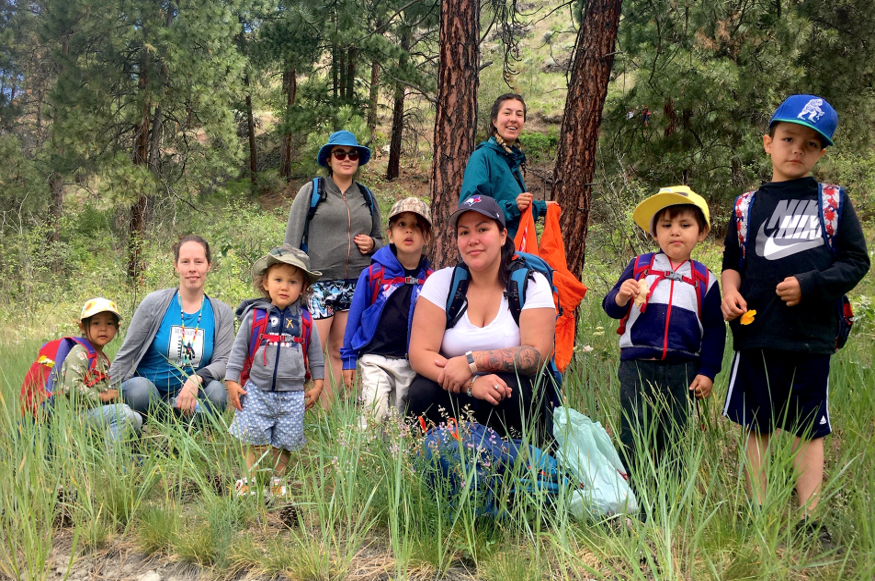
Sʔím̓ laʔxʷ Michele Johnson PhD (Syilx) is Executive Director, lead activist, and teacher at the Syilx Language House. She is a member of Okanagan Indian Band, related to Simlas and Richters with Syilx and Suyápix (Euro) ancestry. Johnson is certified n̓łəqʷčin̓ (high-intermediate) by Sʕam̓ tíc̓aʔ Peterson and Chris Parkin of the Salish School of Spokane (Paul Creek). She spearheaded the n̓ql̓xʷčn̓iłxʷ “language house” model during her doctoral and postdoctoral research in Indigenous language revitalization at the University of British Columbia and Simon Fraser University. The following is an excerpt of Johnson’s keynote address at the “Restoring and Protecting Our Native Languages and Landscapes” Conference. It has been lightly edited for clarity and continuity.
The Syilx Language House was formed in 2015 at the request of the Chiefs and Councils from three of our Syilx partner communities. N’syilxcn is a critically endangered Interior Salish language. There are fewer than two dozen fluent Elders remaining in the entire Syilx territory, which is quite large geographically, spanning southern British Columbia, Canada, and northern Washington, and has a population of around 10,000 people. This calls for radical methods because of the critically endangered status, large size, and so few people and Elders. Following the recommendations of the late language revitalizer and Director of the Piegan Institute, Darryl Kipp (Blackfeet), N’syilxcn is now a full time language domain for us. We teach adults in small groups following a sequenced intensive Salish Curriculum for 1,600 hours. We also record and share freely our Elder stories. Pre-COVID-19, we ran an immersion nest for toddlers. We face barriers and we build realistic solutions. The adults are paid to learn full time and adult lessons are working phenomenally over Zoom. We follow a world class curriculum. We are so lucky to have this curriculum created by the Salish School of Spokane. Our program has real-time results and these methods are mobile.

My current group of intrepid language warriors meets four days a week on Zoom for three hours per day. They achieve 550 hours of sequenced curriculum in a calendar year, and they are all paid to be there. We are inspired by some really smart people, including Kipp, who said, “work with the ones who want it. Do not ask permission to save your language.” We are also inspired by Hawaiians who worked with the ones who wanted it, and now have thousands of children being raised in Hawaiian. Sʕam̓ tíc̓aʔ Sarah Peterson, our wonderful fluent Elder; we have so much love for her because she recorded thousands of hours of audio files with our sequenced curriculum. Joshua Fishman inspired me from the beginning with his Graded Intergenerational Disruption scale of one to eight that measures a language’s vitality, with eight being critically endangered of going silent. When your language is at eight, it is best not to focus on creating a school or a radio program; it’s too early to form a school when you don’t have any fluent adults yet to run it.
Chris Parkin and Larae Wiley at the Salish School of Spokane wrote the Salish Curriculum with the late Sʕam̓ tíc̓aʔ Peterson. They run an immersion school in Spokane for 75 children and 30 staff. All of those people are on the road to fluency, and we follow in their footsteps. Language revitalization means to bring back to life. Herman Edward, a fluent speaker in our language territory says, “We are the ones who will revitalize our languages.”
What is fluency? You hear people say it takes a lifetime to become fluent; it actually takes about 4,000 to 10,000 hours to become an advanced speaker. If you are in a program that is teaching 1,000 to 2,000 hours, the highest you will achieve is high intermediate, and that is with a lot of dedication and homework. We know in my language program that we need for some people to get to advanced in this lifetime.

A program of 4,000–10,000 hours will result in advanced speakers. In my personal experience, the success factors to fluency include safety as the number one. So many of our language programs have been taught in a way that causes people to feel very insecure about language. Our program and the curriculum is designed to have safety in the classroom. Our first 200 hours of curriculum-based lessons are fun and interactive. They really build confidence because classroom safety is paramount in language learning.
Language tension is important to recognize for learning. If the tension is too high you can’t learn, and if the tension is too low you can’t learn. We have created a domain based on immersion. You can’t expect people to revitalize the language on evenings and weekends. The Salish Curriculum is 12 complete binders with about 300 pages each that have partner exercises, audio clips, computer programs, teaching methods, and lesson plans. Each textbook takes about 200 hours to teach. I’m going to share with you a little bit about what it’s like in an adult classroom that’s following the sequenced curriculum. It’s amazing. We find it transformational and it can be scary. And that’s why classroom safety is so important: kindness is built into the curriculum. The curriculum is designed so that when you learn the book, you teach the book. And once you’re teaching the book, that’s when your learning really takes off.
These methods and curriculum are now translated into about 10 different languages, which is very exciting. For example, I could train you in how to write and teach these books, even if you’re a beginner. Now, keep in mind, this is for critically endangered languages. If you still have 3,000 fluent speakers that are under the age of 40, you can follow different methods. But if your language is like mine and you have very few fluent speakers and they’re all over the age
of 60 or 70, these are the methods for you.

The next steps after the four-year fluency program are to create domains of use. For our language that will be a language nest, a school, and a fluency full time recording team for adults, for Elders. We embed into our programs lateral kindness training for staff to combat lateral violence and support each other through intergenerational trauma. We incorporate nonviolent communication methods and also methods from stand-up comedy. We graduated eight adults in 2019 and made a film showing our speaking ability. This is really heartwarming; because we have reached a mid-intermediate speaking proficiency, we’re able to talk about our experience in the language, in Nsyilxcn. We created a wonderful language nest for toddlers and staff, which ran for an entire year and was our way of using our language skills in immersion with children out on the land. Once staff had received 200 hours of language training, they were ready to take their skills out on the land with children and play simple immersion games and activities. Staff continued to receive language lessons each day. The nest was closed by three things: COVID-19, language tensions, and interpersonal conflict. When we do this again, we will start it with lateral kindness training
and professionalism.
We also work with Elders and record and publish Elder recordings each year. This knowledge is a priority to us. We partner with Victor Antoine, Grouse Barnes, Herman Edward, Theresa Ann Terbasket, and other Elder speakers to fill a gap in advanced literature. The recordings can all be accessed on our website, thelanguagehouse.ca. All of our recordings are freely shared. You can download, listen, and use them.
In the classroom, we’ve experienced language tension, a normal feature of language learning, as well as the tension of growth and the tension of creating a domain. What we’ve learned is the necessity of picking yourself up after setbacks. When you encounter a barrier, just know it’s been encountered by every other language warrior before you.
We just keep going because we know our language is important. It’s a sacred responsibility that we have to bring this language back in our lifetime. I’m humbled by the amount of dedication and how the students show up every day.
To learn more about the Syilx Language House, visit thelanguagehouse.ca. To access the sequenced curriculum, a free download that can be translated into any language,visit: interiorsalish.com.
All photos courtesy of Sʔím̓ laʔxʷ Michele Johnson.
